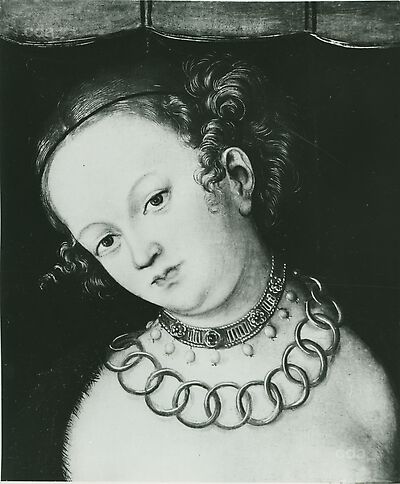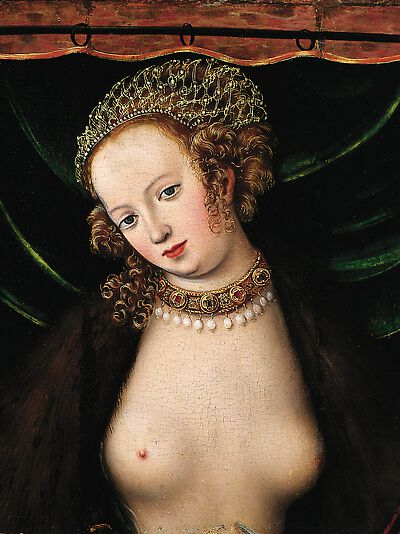The fragmentary painting depicts Lucretia inclined slightly to the left and looking out at the viewer. She is wearing a fur-trimmed cloak over her naked body and her blond curls are pinned up. She wears a large linked chain around her neck as well as chain decorated with pearls and
The fragmentary painting depicts Lucretia inclined slightly to the left and looking out at the viewer. She is wearing a fur-trimmed cloak over her naked body and her blond curls are pinned up. She wears a large linked chain around her neck as well as chain decorated with pearls and precious stones. The folds of a curtain are faintly indicated in the background.
According to the legend Lucretia lived in the 6th century BC and was the beautiful and virtuous wife of the roman Collatinus. The roman King's son - Sextus Tarquinius fell in love with her. During a stay in her house Sextus threatened to kill her and shame her honour if she did not surrender to him. After the rape Lucretia had her father and husband vow vengeance and then she stabbed herself. The event led to an uprising in which the royal family was overthrown and the Roman Empire became a Republic. Depictions of Lucretia who was seen as the epitomy of female virtue, chastity, fidelity and honour enjoyed great popularity, particularly in the 16th century. [Literature: Bierende 2002, Follak 2002, Livius 1909]
- Attribution
- Lucas Cranach the Elder
Attribution
| Lucas Cranach the Elder | [Friedländer, Rosenberg 1979, 118, No. 240L] |
- Production date
- about 1526 - 1537
Production date
| about 1526 - 1537 | [Friedländer, Rosenberg 1979, 118, No. 240L] |
- Dimensions
- Dimensions of support (fragment): 19.5 x 16 cm
Dimensions
Dimensions of support (fragment): 19.5 x 16 cm
[Friedländer, Rosenberg 1979, 118, No. 240L]
Slightly differing measures after Koepplin: 18 x 15.5 cm [handwritten annotation D. Koepplin on the reverse of a photograph in the Archive D. Koepplin]
- Signature / Dating
None
- Owner
- Private Collection
- Repository
- Private Collection
- CDA ID
- PRIVATE_NONE-P230
- FR (1978) Nr.
- FR240L
- Persistent Link
- https://lucascranach.org/en/PRIVATE_NONE-P230/

